#pearson correlation
Explore tagged Tumblr posts
Text
Per-Capita Income and Life Expectancy : W3 Data Analysis Tools
For the third week’s assignment of Data Analysis Tool on Coursera, we would continue to be working with GapMinder's dataset which contains statistics in the social, economic, and environmental development variable at local, national, and global levels
We would be studying the effect of Income per Person of a County on prevalent rates of life-expectancy. Since both the explanatory variable (Per-Capita Income) and the response variable are quantitative we'll calculate the Pearson Correlation Coefficient to analyze the strength of correlation between the variables.
The Correlation Analysis between the two variables gives :

The Correlation Coefficient is 0.60 with a very low p-value << 0.0001, which indicates a considerably strong and significant relation between the Per-Capita Income and the Life Expectancy of individuals. A positive Correlation Coefficient indicates that the Life-Expectancy increases with the Per-Capita Income of a Country.

However, looking at the scatter-plot between the two variables, we see that a sharp increase in the life expectancy is seen only at the very low end of the per-capita income spectrum. Beyond a per-capita income of 10000, the life-expectancy almost flattens out. So, we need to understand the strong relationship between the variables together the scatter-plot.
0 notes
Text
Generating a Correlation Coefficient Assignment
My Program:


Program Output and Summary:
Pearson Correlation Test Results for life expectancy and HIV rate


A Pearson Correlation test revealed an association between life expectancy and HIV rates that is statistically significant, p-value approx. 1.55e-13, and moderately negative, coefficient approx. -0.56, which is clearly illustrated by the scatterplot graph above.
Thus, knowing the life expectancy will help with predicting approx. 31 percent of the variability seen in HIV rates, coefficient squared is approx. 0.3177.
Pearson Correlation Test Results for life expectancy and breast cancer cases


A Pearson Correlation test revealed an association between life expectancy and breast cancer cases that is statistically significant, p-value approx. 1.54e-19, and moderately positive, coefficient approx. 0.66, which is clearly illustrated by the scatterplot graph above.
Thus, knowing the life expectancy will help with predicting approx. 43 percent of the variability seen in breast cancer cases, coefficient squared is approx. 0.4364.
0 notes
Text

damn just because i was a waitress for a week
17 notes
·
View notes
Text

research moment.
#soup draws#comics#academia#i guess#if u were curious#the numbers are supposed to be pearson's r correlation btw#you want it to be close to 1 (or negative 1)
3 notes
·
View notes
Text
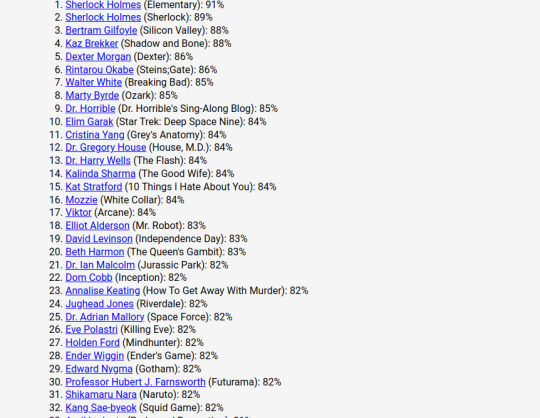

this quiz sorts through characters from like dozens of fandoms and finds the one you’re most like. I’m not even a little bit surprised by my result
#i got 91 % sherlock holmes from elementary using pearson correlation#i have not watched it#nor read the original novels#and i got betram gilfoyle from sillicon valley using mean difference#i have not watched sillicon valley either but it tracks due to my job involving programming#most of the characters i got in universes are scientists in some way or villains
59K notes
·
View notes
Text
i feel like ive done all that i could to prepare for the exam and i dont know how thats supposed to make me feel
#i dont know if thats a bad thing or a good thing#but either way i cant do anything about it anymore#i will just read all my science reviewers and then go to sleep#i want to pass but if i fail then i can just give an appeal so im not so stressed about it#OH SHOOT nevermind i also have to memorize formulas for math goodbye#good luck to me#annuities 🔪🔪🔪#they said correlation is on the test too but dude i am not memorizing the formula for pearson's r
0 notes
Link
Rumus-Rumus Excel terlengkap
#Rumus Confidence#Rumus Correl#Rumus Count Conta#Rumus Contif#Rumus Fdist#rumus Ftest#rumus Normdist#rumus NORMINV#rumus PEARSON. rumus PERCENTILE#rumus percenrank#rumus permut#rumus poisson#rumus prob#rumus slope#rumus excel
0 notes
Text
Closed
Hi, peeps! Please excuse any inaccuracies in my writing. Enjoy!
Summary: Harvey closed yet another deal. So, what's new?
Warnings: Nothing
"Where the hell were you?" Harvey barges into your office, unannounced, and with such force. You slide the pamphlet you’re reading underneath a pile of documents in front of you and hope to God that Harvey didn’t realize your abrupt movement. "Where the hell were you, and what are you hiding? Answer the questions consecutively," Harvey says sternly while looking you dead in the eyes. “Okay, so umm." You paused and realized how Harvey was looking at you skeptically. You have to pull yourself together. You can speak in the middle of a courtroom with such elegance, determination, and confidence. But Harvey Goddamn Specter strips it out of you.
" The answers to questions one and two were correlated. " Harvey sighs, "then starts answering. Smith was my old client, and I know how long it takes to get from his house back to the office. You took almost 3 hours and blew me over in our meeting.” Shit. You forgot completely about the meeting. You were supposed to be in this meeting with Harvey hours ago. “So, pray tell, where were you and what happened?” Harvey sits himself down on a chair across from yours. "Like the initial plan, I went to Smith’s place to drop the final contract. I was about to go straight back here until I saw something just on his doorstep." You bite your lips, contemplating how you should proceed with this story. Harvey nods his head, encouraging you to continue. "I saw a black kitten, alone.” You see Harvey’s eyebrows draw closer together. "So I took him to the vet to make sure if he’s okay and all.” Harvey’s lips turn into a straight line. "You bailed from our meeting for a cat?” You flinch at his tone. When you choose to work for Pearson Specter in the middle of dating Harvey, you know that he won’t always be your boyfriend. You know there will come days like this when he is nothing but your boss. And you know you are in the wrong for this. "I’m sorry, Harvey. It won’t happen again. My emotions got the best of me, and I didn’t think it through. I’m sorry." Harvey sighs and leans back on the chair. "Where’s the cat?” Harvey asks. Again, you bite your lips and point at the corner of your office. Harvey follows where your finger points, takes a solid 5 seconds to look at the crate with a sleeping black kitten inside it, and looks back at you. You start before he says anything: "I won’t have any meetings with anyone in my office today. And you didn’t even realize he'd been there since you got into my office, right?” Harvey just stares at you. "Don’t let something like this happen again. I wasn’t only pissed because you hung me dry in our meeting; I was worried about you too. I’ve insisted you should take Ray.” Harvey stands up, and you find yourself following his movement as if he were your client. You get more nervous under the scrutiny of your own boyfriend than all your clients. He can be intimidating when he needs to be. He starts to walk for the door before you say, "What about the kitty?” Not only do you ask for his existence here, but you also subtly ask if you can bring it home. Harvey stops and looks like he’s contemplating his choices before he looks back at you. "Bring the cat home until you find the cat an adopter. Talk to Louis; he likes cats.” Harvey leaves you alone, sad about his answer.
------------------------------------------------------------------------------
It’s 7 p.m. when you turn off your laptop and decide to finally go home. Timmy, the black kitten you found earlier today, is still sleeping soundly in his little bed. You grin, looking at him. You have to admit that you already love this cat. You replay what Harvey said to you, and your heart heaves at the option you have. No, you think to yourself. You’ll fight Harvey, so he’ll let the cat stay. You’re also a lawyer yourself anyway. You sure can wiggle around to get something you want. You call Ray to help you bring down the crate while you walk down the hallway to go fetch Harvey. The room is dark, but you see Donna still at her desk. You lean on her desk, and she smiles. "Where’s Harvey?" you ask as you peek inside, trying to find any sign of him in case your eyes deceive you. "He didn’t tell you? He went to Atlantic City to close a deal after lunch," Donna says as she studies you. Harvey always tells you everything. "The Blanchard case?" you ask, and Donna nods. "Why didn’t he tell you?” Donna asks; all are curious. "I ditched the meeting we had. I was supposed to go back to the office after I dropped a document, but I saw a kitten," you pause as you shuffle around to grab your phone. "This is Timmy, the kitten in question.” You show your phone to Donna, and she smiles. "He was all alone?" and you nod. "I took him to the vet and forgot I was supposed to be Harvey’s number two at that meeting." You put your phone back inside your handbag. "He went all Boss Harvey on me, not that I blame him. But he told me we couldn’t keep the cat." Donna looks at you and smiles again. "We all know how he deals with emotions. He was more worried about you than you missed the meeting. You huff and nod, "Yeah, we all know he’s trying," and you smile weakly. "Just go home after you’re done, Donna. I gotta go home and get Timmy situated in the house." You wave her goodbye as you walk to the elevator.
------------------------------------------------------------------------------
Once you get home with Ray bringing the crate inside and all, you sit by the kitchen and try to listen for any sign of Harvey’s arrival. He won’t stay out for the night; he was mad, but he’ll get home. You know that. After jolting out notes on your current case, you hear a ding outside from the elevator. You close the file and run to the door, ready to welcome him home. He opens the door to you, smiling. He looks tired but smiles once he sees you grinning. "Welcome home," you say as you cup his cheeks with your hands and give him a kiss. "What an excellent service," Harvey whispers, his lips touching yours. "I’m sorry about today," Harvey says as you lead him inside. "If anything, I’m the one who is sorry. About the meeting, about making you worry. He stops both of you in the middle of the hallway and kisses you. You smile against his lips, take his coat off, and walk further inside. “Harvey, look," you say as you point near the couch. "You’ve found an adopter?" Harvey asks as he takes the mug of warm tea you offer him. "I’m thinking of keeping him here.” You say it carefully. Harvey sighs, as he takes your hand and leads you to sit with him on the couch. He sits you down as he faces you. "We can’t keep him, baby.” You instantly pouted at his words. "Because you know both of us are busy. A pet is a big responsibility.” Harvey explains with a stern voice, trying to make you see reason. "But Louis had Bruno,�� you said defensively. "Bruno died because Louis was too busy to realize he was sick. And why do you think he hasn’t got another cat yet?" You see where this is going. "I want you to be happy, and you know that. But a cat with our work schedule right now will be quite hard, don’t you think?” As you look down at your intertwined hands, tears threaten to escape. You really do love Timmy. “Remember, we made a promise; once we marry and decide to start a family, we’ll lessen our workload and move to a bigger place. We’ll have more time then. And we can have 10 dogs and 20 cats.” He cups your cheek for you to look up at him and smiles as he wipes the tears from your cheek. You see his reason and just nod. Harvey kisses your forehead before saying something about a bath and bed.
------------------------------------------------------------------------------
Harvey sighs as he looks at the time on his phone. 2.30 am. He looks down at you, sleeping soundly. He carefully untangles you from him. He walks to the kitchen and retrieves a bottle of cold water from the fridge. He chooses to work for a bit as he opens the door to his home office. He’s deep in some files when he sees a movement just at the door, and he snaps his head up. He cocks his head at the sight of the cat walking inside his office. The cat uses the chair across from him to climb up to his desk. The cat sits down, looking at Harvey. Harvey has no choice but to look back at the cat. And so the staring contest begins. Harvey looks at the little creature and contemplates how much this cat can make his girl happy. He believes a cat won’t require as much care as a dog. He remembers the tears and the pout on his girl’s face when he said they couldn’t keep the cat. He remembers how she was an only child and never really had a friend growing up. He petted the cat in the head. The cat looked cautious at first, but then he closed his eyes and purred. "Okay, bud. Here’s what we’re gonna do. We’ll make our girl happy, you and I. And in return, you’ll get the best care this world has to offer, deal?"
------------------------------------------------------------------------------
Note: Feel free to send me a request! Thanks!
MASTERLIST
#harvey specter#harvey specter imagine#harvey specter fan fiction#harvey specter imagines#harvey specter fanfic#harvey specter x reader#suits harvey specter#suits tv
468 notes
·
View notes
Text
I was so excited to take this you wouldn’t even believe. Thanks for the tag!

My top result!! I’ve never watched this show but I know who this is!!








Top ten and results that I knew. :3
I’m very nerd-coded. I’d be the character that constantly goes “uhm actually 🤓☝️”
Tags: @desire-mona @wilsons-three-legged-siamese @1mlostnow @clouds-soup @oh-cramity-its-amity @soobiesworld @sweaty-toothed-mad-woman @pingunaa @sapphosdickandballs and otherwise open tags <3
It's been years since I last took this test [what fictional character are you] and the first time I took it, I got Klaus Hargreeves and that's why I even got into TUA in the first place. It would be fun to retake it, especially since it has more results now.
Don't know who this is but that's the fun part of this quiz

I checked some results from shows/movies I watch and this is what I got




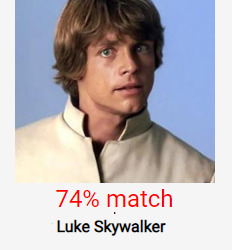
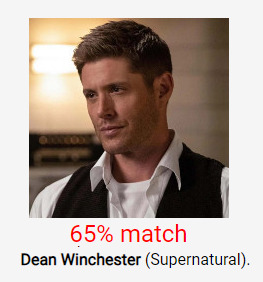
Tagging (no pressure!): @lis-likes-fics @virtie333 @dumbgothbunny @marc-spectorr @soft-girl-musings @iraniq @lucywrites02 @babiiface95 @my-secret-shame @blackroseyaz @vcat55 @kermitgasm @whatthefishh @stargazingcarol @nathanbatemanfucker @inklore and anyone who sees this 💚
#avery I can be the wilson to your house#perhaps 👉👈#yes I took the 140 question version#I love personality assessments#because they call me out for being a huge fucking nerd!!!!#like yes I’m twilight sparkle#thank you very much#tag game#talking to my friends#I wiggled around like a happy worm when I saw Wilson I was so excited#featuring my favorite book#I love you enders game you changed my life at like eleven years old#edit#not to add more tags oops#but when I changed algorithm to mean difference instead of Pearson correlation#Wilson was at 83%#trust i can be Wilson to your house
38 notes
·
View notes
Text
Why a Spinoff for Tarlos Is Feasible,Based on AO3 Data.

In this article,I will explain why the decline in Tarlos'popularity is an illusion and why Tarlos'popularity is rebounding and has a solid and reliable core audience in the long term.
It is well-known in American TV shows that the popularity of a ship is reflected in the annual increase of AO3 tags.The popularity of a ship is associated with many factors,such as the director's skills,the scriptwriter's plot design,and the chemistry between actors.
When the director,scriptwriter,and production team remain the same across seasons of the same TV show,these factors may fluctuate but the changes are relatively small.In such cases,people often overlook a key factor affecting the annual increase of AO3 tags:the number of episodes aired in a season!



(Top 100 in 2021,2022 and 2023)
For example,in 2023,compared to 2024,the annual increase of AO3 tags for"TK/Carlos"declined and exited the top 100 for the first time since 2021.Does this mean Tarlos is no longer popular?On the contrary,the conclusion is incorrect because it ignores the number of episodes aired each season.
9-1-1:Lone Star from 2020 to 2023,each year saw a complete season aired,while only nine episodes were broadcast in Season 5 in 2024.

According to the Pearson correlation coefficient formula,the annual increase of tags is strongly positively correlated with the total number of episodes per year(referred to as"episodes").

The correlation coefficient : r≈ 0.645
In statistics,when 0.7≤|r|≤ 1,two factors are considered to have a strong correlation.However,from Seasons 1 to 4,there were fluctuations in production quality.Season 4 had the lowest ratings on various review websites compared to the previous three seasons.Did this fundamental factor affect the tag increase in 2023?
To test this hypothesis,we removed the data from Season 4 and recalculated the Pearson correlation coefficient using data from Seasons 1,2,3,and 5.

The new correlation coefficient:r'≈ 0.845
We then conducted a hypothesis test to verify the p-value:(0.05<p<0.1),which means the correctness rate of the correlation is over 90%.
Thus,under similar production standards,the number of episodes in9-1-1:Lone Starand the annual increase of"Carlos/TK"AO3 tags have a very strong positive correlation.
We can conclude that the main reason for the drop of"TK/Carlos"out of the top 100 in 2024 was the reduced number of episodes aired that year.
Apart from statistical analysis,other factors also played a role:
1. Season 5 premiered at the end of September.By the cutoff date for the rankings(January 1,2025),only nine episodes had been aired.Many viewers hadn't had time to watch,and many fan fiction authors hadn't had time to write.
2. Previous seasons(Seasons 1-4)were broadcast at the beginning or middle of the year,finishing by September at the latest.They attracted viewers for most of the year.In contrast,Season 5 only had three months(from September to December)to attract viewers.
3. The gap between the premiere of Season 5 and the last episode of the previous season was as long as 13 months,longer than the gap between any other seasons.
4. Season 5 had the least official promotion,relying almost entirely on the actors'personal promotions.
In fact,Tarlos'popularity has not declined but increased.The reduced number of episodes in 2024 affected the data and led to a misjudgment.

Focusing on the last column:The Average Contribution per Episode to the Annual Increase in Tags.
In 2024,each of the nine episodes contributed an average of about 150 tags.Compared to last year's figure of 85.8,this represents a year-on-year growth rate of 74.83%.Looking at the past five years,the average contribution per episode this year is close to the historical high,almost comparable to the peak in 2021.
From this analysis,we can see that Tarlos'popularity has been steadily rising since the debut of9-1-1:Lone Starin 2020,reaching its peak in 2021,then entering a stable period,and finally hitting another peak in 2024.
Tarlos has the potential for sustainable growth.If a Spinoff featuring them were to air on streaming platforms or other good platforms,their stable audience and fan base would continue to contribute to the popularity and discussion of Tarlos.
Conclusion:Tarlos has a solid and reliable core audience with the potential for sustainable development and long-term success.
Given the relatively low cost and high return on investment for a derivative series,it is highly feasible.As long as the scriptwriting quality of the derivative series can maintain the level of the original,continued success is not only possible but likely—even more so than before.🔥


30 notes
·
View notes
Text
Abstract
Background: Millions of individuals have reported adverse events (AEs) using the Vaccine Adverse Events Reports System (VAERS) in the context of the gene-based modified mRNA (modRNA) prodrugs designed by Pfizer-BioNTech (BNT162b2/Comirnaty) and Moderna (mRNA-1273/Spikevax) aimed against SARS-CoV-2. Tens of thousands have reported concurrent breakthrough (BT) SARS-CoV-2 infections.
Objectives: To examine the possible link between VAERS reports of BT infection associated with the COVID-19 modified mRNA lipid nanoparticle (LNP)-encapsulated injectable products and reports of class switching toward non-inflammatory, spike-specific IgG4 antibodies especially following a third (or fourth) dose.
Methods: VAERS data was used to examine the frequency of reporting of BT infections linked to the modRNA-LNP COVID-19 products up to and including November 2024 according to dose in the “vaccine dose series” (up to dose 4), and age of the individual reporting the BT infection. Medical Dictionary for Regulatory Activities (MedDRA) Preferred Term codes “COVID-19”, “SARS-CoV-2 test positive”, “Vaccination failure”, “BT COVID-19”, "Vaccine BT infection" were used to query BT infections in the VAERS domestic dataset. These data were compared to literature-based findings indicating a shift to tolerizing (non-inflammatory) spike-specific IgG4 antibodies following third and fourth doses.
Results: There are 68,504 BT infection reports in VAERS domestic data following modRNA COVID-19 injection spanning 2020-2024 for all reports with complete age and dose 1-4 data. The highest percentage of dose-specific BT reports of total BT reports is seen following dose 4 (30%), followed by dose 3 (16%) and doses 1 and 2 (4% and 12%, respectively), even though the absolute counts of reports per dose are highest in the cases of doses 1 and 2 (N=11,330, N=31,739, N=14,999, N=10,4368, for doses 1-4, respectively). An emergent pattern in dose 4 data not seen for doses 1-3 - whereby peak reporting for 55-77-year-olds far exceeds that for doses 1-3 – was discovered following normalization of the data per 100,000 BT infection reports/age for each dose. In fact, according to Pearson Correlation, there is only a very weak correlation between doses 1 and 4 (r(97) = .45; p < .001), no correlation whatsoever between doses 2 and 4 (r(97) = .19; p = .06), and a weak correlation between doses 3 and 4 (r(97) = .58; p <.001). Doses 2 and 3 were also well correlated (r(108) = .68; p < .001). On the other hand, there is a strong significant correlation between doses 1 and 2 (r(116) = .85; p < .001) and doses 1 and 3 (r(108) = .94; p < .001). This significant difference is age-related and manifests for ages 55-77. The Area Under the Curve (AUC) for the normalized rates was calculated for dose 1 and dose 4 between the ages of 55 and 77 and the difference was found to be significant, with the dose 4 AUC being greater. Increased rates of breakthrough infection reports could be due to conferred susceptibility to SARS-CoV-2 following multiple doses of modRNA products that align with a 19.27% rise in IgG4 following dose 3 published in the literature.
Conclusions: The rates of BT reporting in the contexts of modRNA COVID-19 products are higher following dose 4 according to VAERS data. This is a compelling finding and corroborates evidence that class switching toward noninflammatory, spike-specific IgG4 antibodies confers susceptibility to COVID-19.
5 notes
·
View notes
Text
This is the coolest personality quiz I’ve ever seen and it’s incredible
Answer questions with sliders and then you get assigned a character from a list of 2,000! I freaking love statistics!!!!!
My results when I took the recommended version of the test:
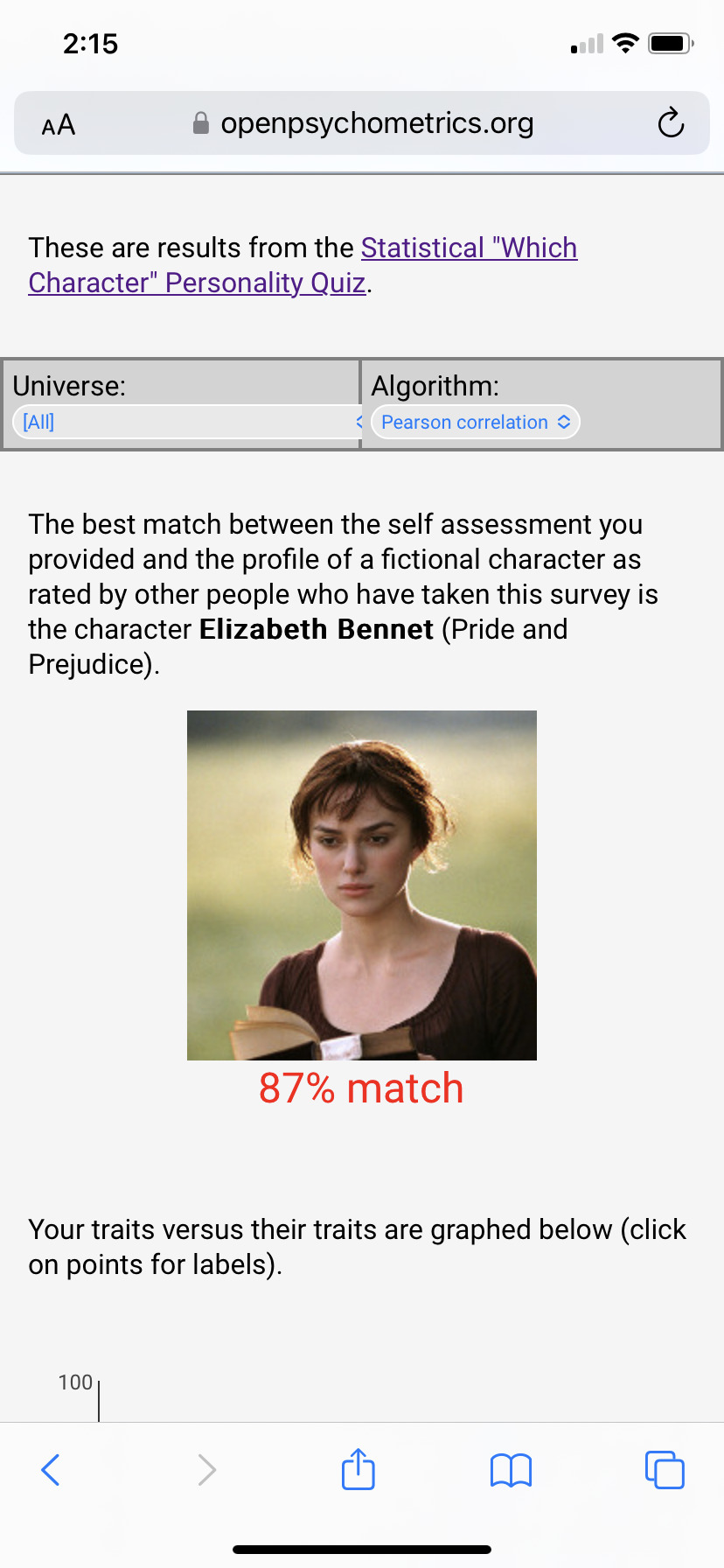
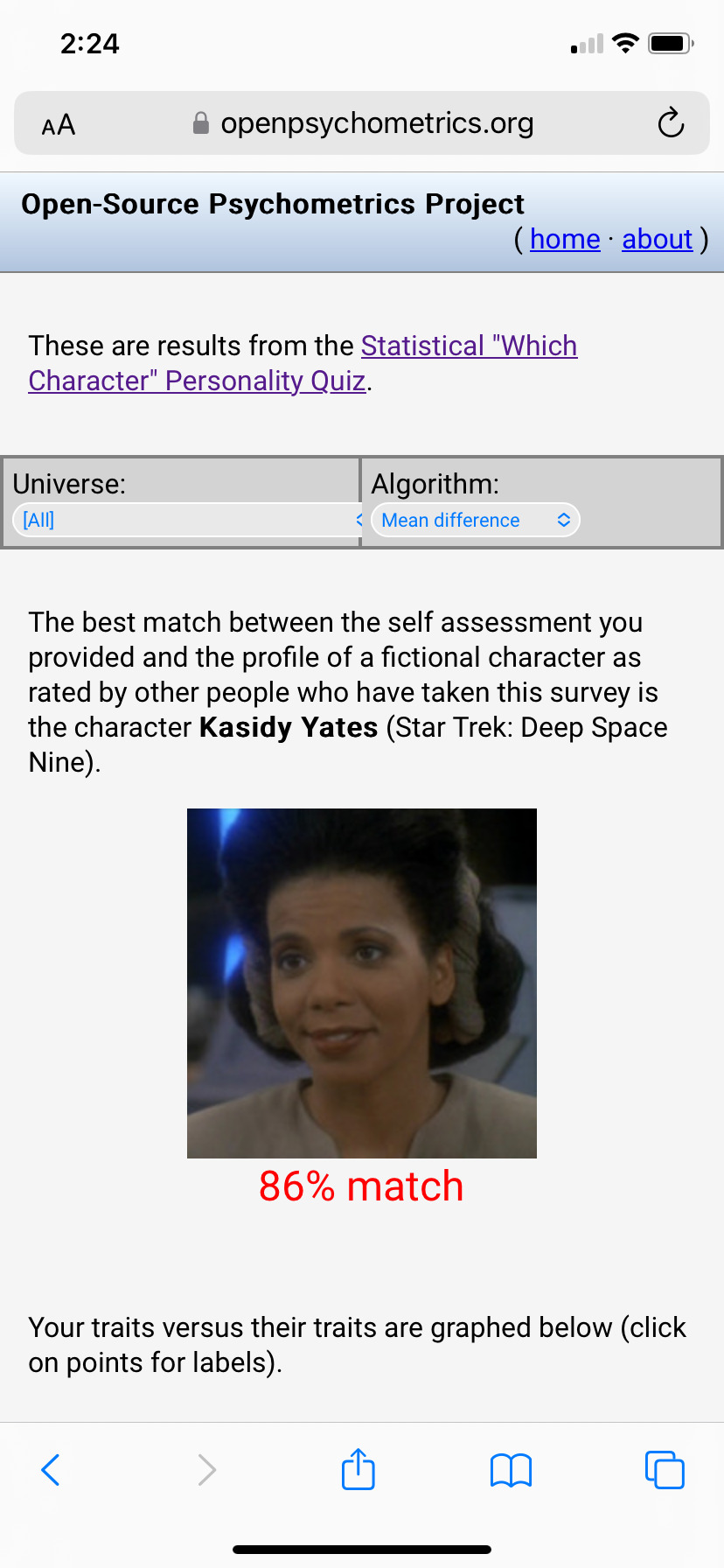
My results after taking the 140-question exhaustive version:
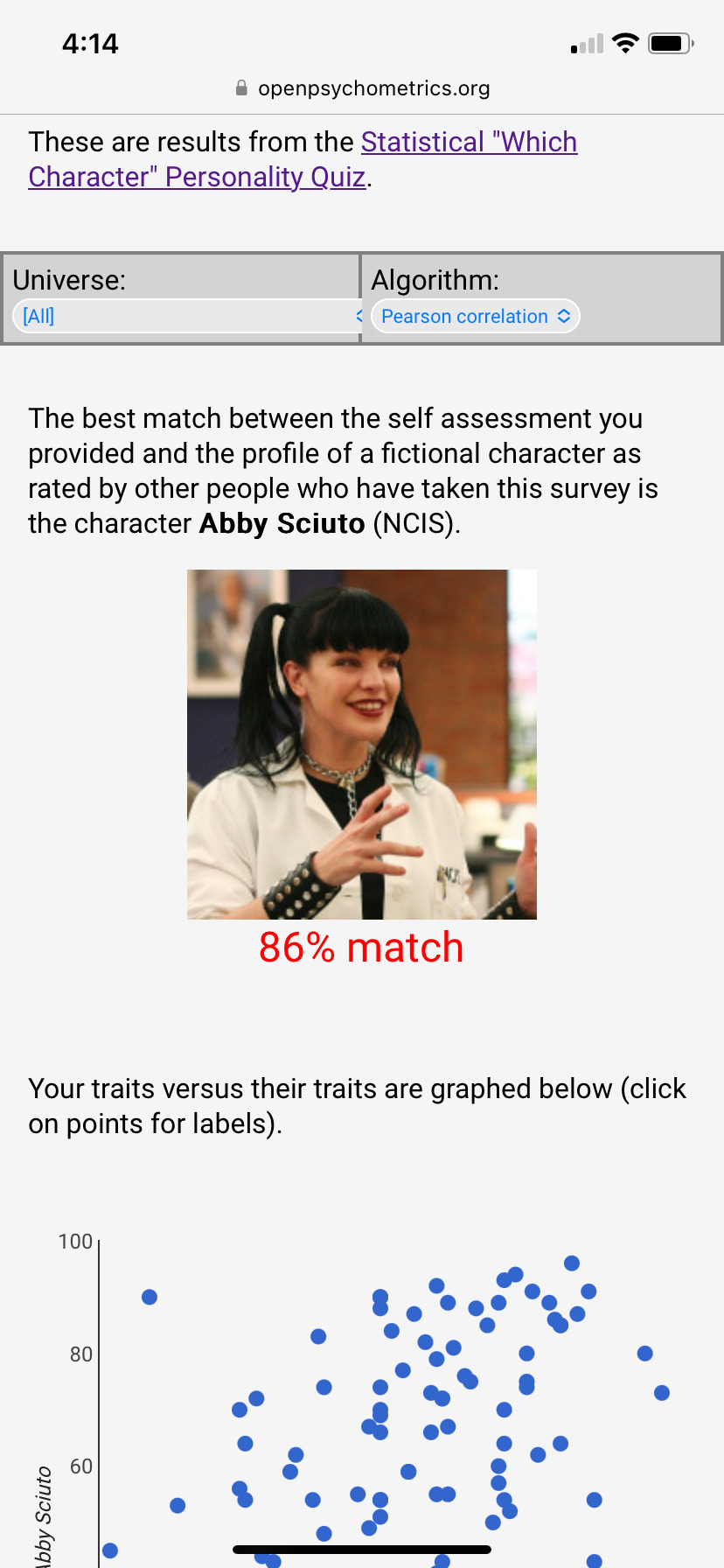
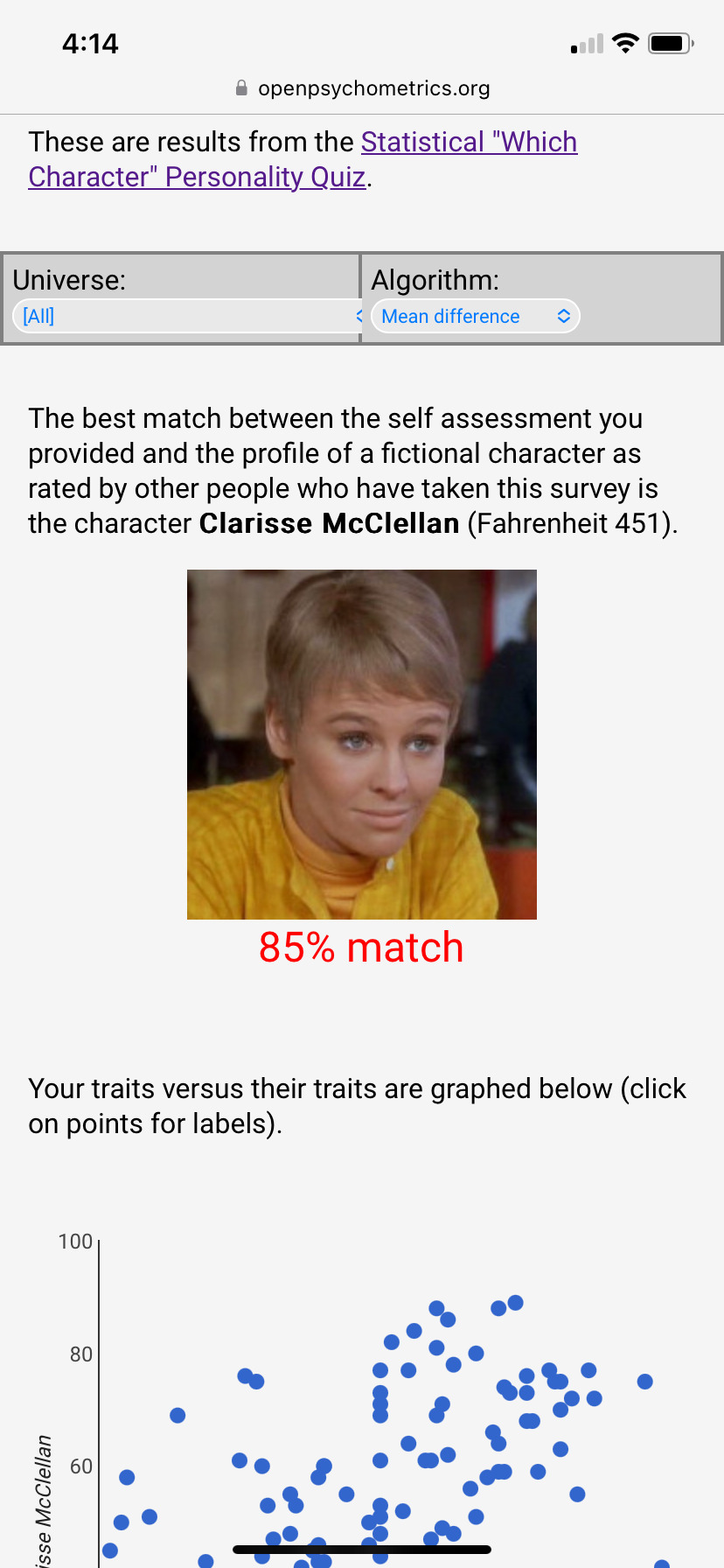
(There’s two for each because on the left is Pearson correlation and left is mean difference)
Rebloging with what you got :)
The DS9 character I’m most like: *very happy about this*

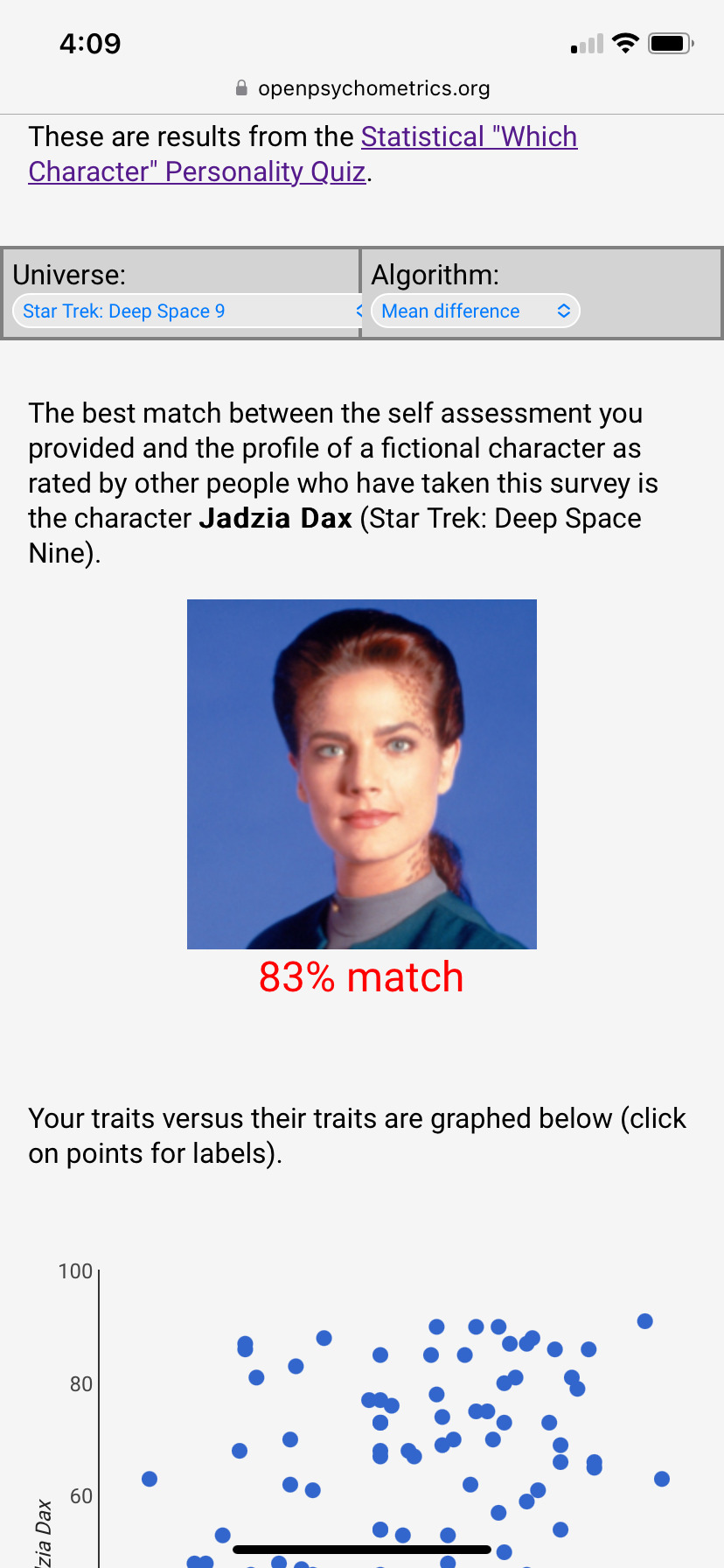
#statistics#which character are you#star trek#star trek deep space 9#star trek the next generation#star trek voyager#the vampire diaries#twilight#Ncis#pride and predujice#farenheit 451#alien 1979#agents of shield#marvel cinematic universe#downton abbey#the x files#Avatar the Last Airbender#frozen#the boys#futurama#arcane#fast and furious#personality quiz
18 notes
·
View notes
Note
How you come with that fuckin lore sheet (like not even in my messiest dreams I could connect all of your writings 😭😭)
There is a small chance that my need to organize literal figments of imagination might be related to my ‘tism. Can’t say for sure, I’ll have to run a correlation test in SPSS and get back to you once I have a Pearson coefficient.
I’m also uncertain whether you’re referring to the reader guide featuring my old stories, or the recent human kink compilation (I’m guessing the latter), but it sadly doesn’t change the verdict.
18 notes
·
View notes
Text
Inhibition of EIF4E Downregulates VEGFA and CCND1 Expression to Suppress Ovarian Cancer Tumor Progression by Jing Wang in Journal of Clinical Case Reports Medical Images and Health Sciences
Abstract
This study investigates the role of EIF4E in ovarian cancer and its influence on the expression of VEGFA and CCND1. Differential expression analysis of VEGFA, CCND1, and EIF4E was conducted using SKOV3 cells in ovarian cancer patients and controls. Correlations between EIF4E and VEGFA/CCND1 were assessed, and three-dimensional cell culture experiments were performed. Comparisons of EIF4E, VEGFA, and CCND1 mRNA and protein expression between the EIF4E inhibitor 4EGI-1-treated group and controls were carried out through RT-PCR and Western blot. Our findings demonstrate elevated expression of EIF4E, VEGFA, and CCND1 in ovarian cancer patients, with positive correlations. The inhibition of EIF4E by 4EGI-1 led to decreased SKOV3 cell clustering and reduced mRNA and protein levels of VEGFA and CCND1. These results suggest that EIF4E plays a crucial role in ovarian cancer and its inhibition may modulate VEGFA and CCND1 expression, underscoring EIF4E as a potential therapeutic target for ovarian cancer treatment.
Keywords: Ovarian cancer; Eukaryotic translation initiation factor 4E; Vascular endothelial growth factor A; Cyclin D1
Introduction
Ovarian cancer ranks high among gynecological malignancies in terms of mortality, necessitating innovative therapeutic strategies [1]. Vascular endothelial growth factor (VEGF) plays a pivotal role in angiogenesis, influencing endothelial cell proliferation, migration, vascular permeability, and apoptosis regulation [2, 3]. While anti-VEGF therapies are prominent in malignancy treatment [4], the significance of cyclin D1 (CCND1) amplification in cancers, including ovarian, cannot be overlooked, as it disrupts the cell cycle, fostering tumorigenesis [5, 6]. Eukaryotic translation initiation factor 4E (EIF4E), central to translation initiation, correlates with poor prognoses in various cancers due to its dysregulated expression and activation, particularly in driving translation of growth-promoting genes like VEGF [7, 8]. Remarkably, elevated EIF4E protein levels have been observed in ovarian cancer tissue, suggesting a potential role in enhancing CCND1 translation, thereby facilitating cell cycle progression and proliferation [9]. Hence, a novel conjecture emerges: by modulating EIF4E expression, a dual impact on VEGF and CCND1 expression might be achieved. This approach introduces an innovative perspective to impede the onset and progression of ovarian cancer, distinct from existing literature, and potentially offering a unique therapeutic avenue.
Materials and Methods
Cell Culture
Human ovarian serous carcinoma cell line SKOV3 (obtained from the Cell Resource Center, Shanghai Institutes for Biological Sciences, Chinese Academy of Sciences) was cultured in DMEM medium containing 10% fetal bovine serum. Cells were maintained at 37°C with 5% CO2 in a cell culture incubator and subcultured every 2-3 days.
Three-Dimensional Spheroid Culture
SKOV3 cells were prepared as single-cell suspensions and adjusted to a concentration of 5×10^5 cells/mL. A volume of 0.5 mL of single-cell suspension was added to Corning Ultra-Low Attachment 24-well microplates and cultured at 37°C with 5% CO2 for 24 hours. Subsequently, 0.5 mL of culture medium or 0.5 mL of EIF4E inhibitor 4EGI-1 (Selleck, 40 μM) was added. After 48 hours, images were captured randomly from five different fields—upper, lower, left, right, and center—using an inverted phase-contrast microscope. The experiment was repeated three times.
GEPIA Online Analysis
The GEPIA online analysis tool (http://gepia.cancer-pku.cn/index.html) was utilized to assess the expression of VEGFA, CCND1, and EIF4E in ovarian cancer tumor samples from TCGA and normal samples from GTEx. Additionally, Pearson correlation coefficient analysis was employed to determine the correlation between VEGF and CCND1 with EIF4E.
RT-PCR
RT-PCR was employed to assess the mRNA expression levels of EIF4E, VEGF, and CCND1 in treatment and control group samples. Total RNA was extracted using the RNA extraction kit from Vazyme, followed by reverse transcription to obtain cDNA using their reverse transcription kit. Amplification was carried out using SYBR qPCR Master Mix as per the recommended conditions from Vazyme. GAPDH was used as an internal reference, and the primer sequences for PCR are shown in Table 1.
Amplification was carried out under the following conditions: an initial denaturation step at 95°C for 60 seconds, followed by cycling conditions of denaturation at 95°C for 10 seconds, annealing at 60°C for 30 seconds, repeated for a total of 40 cycles. Melting curves were determined under the corresponding conditions. Each sample was subjected to triplicate experiments. The reference gene GAPDH was used for normalization. The relative expression levels of the target genes were calculated using the 2-ΔΔCt method.
Western Blot
Western Blot technique was employed to assess the protein expression levels of EIF4E, VEGF, and CCND1 in the treatment and control groups. Initially, cell samples collected using RIPA lysis buffer were lysed, and the total protein concentration was determined using the BCA assay kit (Shanghai Biyuntian Biotechnology, Product No.: P0012S). Based on the detected concentration, 20 μg of total protein was loaded per well. Electrophoresis was carried out using 5% stacking gel and 10% separating gel. Subsequently, the following primary antibodies were used for immune reactions: rabbit anti-human polyclonal antibody against phospho-EIF4E (Beijing Boao Sen Biotechnology, Product No.: bs-2446R, dilution 1:1000), mouse anti-human monoclonal antibody against EIF4E (Wuhan Sanying Biotechnology, Product No.: 66655-1-Ig, dilution 1:5000), mouse anti-human monoclonal antibody against VEGFA (Wuhan Sanying Biotechnology, Product No.: 66828-1-Ig, dilution 1:1000), mouse anti-human monoclonal antibody against CCND1 (Wuhan Sanying Biotechnology, Product No.: 60186-1-Ig, dilution 1:5000), and mouse anti-human monoclonal antibody against GAPDH (Shanghai Biyuntian Biotechnology, Product No.: AF0006, dilution 1:1000). Subsequently, secondary antibodies conjugated with horseradish peroxidase (Shanghai Biyuntian Biotechnology, Product No.: A0216, dilution 1:1000) were used for immune reactions. Finally, super-sensitive ECL chemiluminescence reagent (Shanghai Biyuntian Biotechnology, Product No.: P0018S) was employed for visualization, and the ChemiDocTM Imaging System (Bio-Rad Laboratories, USA) was used for image analysis.
Statistical Analysis
GraphPad software was used for statistical analysis. Data were presented as (x ± s) and analyzed using the t-test for quantitative data. Pearson correlation analysis was performed for assessing correlations. A significance level of P < 0.05 was considered statistically significant.
Results
3D Cell Culture of SKOV3 Cells and Inhibitory Effect of 4EGI-1 on Aggregation
In this experiment, SKOV3 cells were subjected to 3D cell culture, and the impact of the EIF4E inhibitor 4EGI-1 on ovarian cancer cell aggregation was investigated. As depicted in Figure 1, compared to the control group (Figure 1A), the diameter of the SKOV3 cell spheres significantly decreased in the treatment group (Figure 1B) when exposed to 4EGI-1 under identical culture conditions. This observation indicates that inhibiting EIF4E expression effectively suppresses tumor aggregation.
Expression and Correlation Analysis of VEGFA, CCND1, and EIF4E in Ovarian Cancer Samples
To investigate the expression of VEGFA, CCND1, and EIF4E in ovarian cancer, we utilized the GEPIA online analysis tool and employed the Pearson correlation analysis method to compare expression differences between tumor and normal groups. As depicted in Figures 2A-C, the results indicate significantly elevated expression levels of VEGFA, CCND1, and EIF4E in the tumor group compared to the normal control group. Notably, the expression differences of VEGFA and CCND1 were statistically significant (p < 0.05). Furthermore, the correlation analysis revealed a positive correlation between VEGFA and CCND1 with EIF4E (Figures 2D-E), and this correlation exhibited significant statistical differences (p < 0.001). These findings suggest a potential pivotal role of VEGFA, CCND1, and EIF4E in the initiation and progression of ovarian cancer, indicating the presence of intricate interrelationships among them.
EIF4E, VEGFA, and CCND1 mRNA Expression in SKOV3 Cells
To investigate the function of EIF4E in SKOV3 cells, we conducted RT-PCR experiments comparing EIF4E inhibition group with the control group. As illustrated in Figure 3, treatment with 4EGI-1 significantly reduced EIF4E expression (0.58±0.09 vs. control, p < 0.01). Concurrently, mRNA expression of VEGFA (0.76±0.15 vs. control, p < 0.05) and CCND1 (0.81±0.11 vs. control, p < 0.05) also displayed a substantial decrease. These findings underscore the significant impact of EIF4E inhibition on the expression of VEGFA and CCND1, indicating statistically significant differences.
Protein Expression Profiles in SKOV3 Cells with EIF4E Inhibition and Control Group
Protein expression of EIF4E, VEGFA, and CCND1 was assessed using Western Blot in the 4EGI-1 treatment group and the control group. As presented in Figure 4, the expression of p-EIF4E was significantly lower in the 4EGI-1 treatment group compared to the control group (0.33±0.14 vs. control, p < 0.001). Simultaneously, the expression of VEGFA (0.53±0.18 vs. control, p < 0.01) and CCND1 (0.44±0.16 vs. control, p < 0.001) in the 4EGI-1 treatment group exhibited a marked reduction compared to the control group.
Discussion
EIF4E is a post-transcriptional modification factor that plays a pivotal role in protein synthesis. Recent studies have underscored its critical involvement in various cancers [10]. In the context of ovarian cancer research, elevated EIF4E expression has been observed in late-stage ovarian cancer tissues, with low EIF4E expression correlating to higher survival rates [9]. Suppression of EIF4E expression or function has been shown to inhibit ovarian cancer cell proliferation, invasion, and promote apoptosis. Various compounds and drugs that inhibit EIF4E have been identified, rendering them potential candidates for ovarian cancer treatment [11]. Based on the progressing understanding of EIF4E's role in ovarian cancer, inhibiting EIF4E has emerged as a novel therapeutic avenue for the disease. 4EGI-1, a cap-dependent translation small molecule inhibitor, has been suggested to disrupt the formation of the eIF4E complex [12]. In this study, our analysis of public databases revealed elevated EIF4E expression in ovarian cancer patients compared to normal controls. Furthermore, through treatment with 4EGI-1 in the SKOV3 ovarian cancer cell line, we observed a capacity for 4EGI-1 to inhibit SKOV3 cell spheroid formation. Concurrently, results from PCR and Western Blot analyses demonstrated effective EIF4E inhibition by 4EGI-1. Collectively, 4EGI-1 effectively suppresses EIF4E expression and may exert its effects on ovarian cancer therapy by modulating EIF4E.
Vascular Endothelial Growth Factor (VEGF) is a protein that stimulates angiogenesis and increases vascular permeability, playing a crucial role in tumor growth and metastasis [13]. In ovarian cancer, excessive release of VEGF by tumor cells leads to increased angiogenesis, forming a new vascular network to provide nutrients and oxygen to tumor cells. The formation of new blood vessels enables tumor growth, proliferation, and facilitates tumor cell dissemination into the bloodstream, contributing to distant metastasis [14]. As a significant member of the VEGF family, VEGFA has been extensively studied, and it has been reported that VEGFA expression is notably higher in ovarian cancer tumors [15], consistent with our public database analysis. Furthermore, elevated EIF4E levels have been associated with increased malignant tumor VEGF mRNA translation [16]. Through the use of the EIF4E inhibitor 4EGI-1 in ovarian cancer cell lines, we observed a downregulation in both mRNA and protein expression levels of VEGFA. This suggests that EIF4E inhibition might affect ovarian cancer cell angiogenesis capability through downregulation of VEGF expression.
Cyclin D1 (CCND1) is a cell cycle regulatory protein that participates in controlling cell entry into the S phase and the cell division process. In ovarian cancer, overexpression of CCND1 is associated with increased tumor proliferation activity and poor prognosis [17]. Elevated CCND1 levels promote cell cycle progression, leading to uncontrolled cell proliferation [18]. Additionally, CCND1 can activate cell cycle-related signaling pathways, promoting cancer cell growth and invasion capabilities [19]. Studies have shown that CCND1 gene expression is significantly higher in ovarian cancer tissues compared to normal ovarian tissues [20], potentially promoting proliferation and cell cycle progression through enhanced cyclin D1 translation [9]. Our public database analysis results confirm these observations. Furthermore, treatment with the EIF4E inhibitor 4EGI-1 in ovarian cancer cell lines resulted in varying degrees of downregulation in CCND1 mRNA and protein levels. This indicates that EIF4E inhibition might affect ovarian cancer cell proliferation and cell cycle progression through regulation of CCND1 expression.
In conclusion, overexpression of EIF4E appears to be closely associated with the clinical and pathological characteristics of ovarian cancer patients. In various tumors, EIF4E is significantly correlated with VEGF and cyclin D1, suggesting its role in the regulation of protein translation related to angiogenesis and growth [9, 21]. The correlation analysis results in our study further confirmed the positive correlation among EIF4E, VEGFA, and CCND1 in ovarian cancer. Simultaneous inhibition of EIF4E also led to downregulation of VEGFA and CCND1 expression, validating their interconnectedness. Thus, targeted therapy against EIF4E may prove to be an effective strategy for treating ovarian cancer. However, further research and clinical trials are necessary to assess the safety and efficacy of targeted EIF4E therapy, offering more effective treatment options for ovarian cancer patients.
Acknowledgments:
Funding: This study was supported by the Joint Project of Southwest Medical University and the Affiliated Traditional Chinese Medicine Hospital of Southwest Medical University (Grant No. 2020XYLH-043).
Conflict of Interest: The authors declare no conflicts of interest.
#Ovarian cancer#Eukaryotic translation initiation factor 4E#Vascular endothelial growth factor A#Cyclin D1#Review Article in Journal of Clinical Case Reports Medical Images and Health Sciences .#jcrmhs
2 notes
·
View notes
Text
The current study, following a sequential mixed-methods design, mainly aimed at investigating the possible predictors of perceived communicative competence (PCC) in English in perceived language proficiency (PLP) and autonomous motivation to learn English.
Methodology: In doing so, 204 homogeneous university English-major students participated in this study based on convenience sampling, and a pool of six students joined the interview sessions based on purposive sampling. The Pearson product-moment correlation coefficient and the multiple regression were conducted to analyze the data.
Results: The results obtained from the Pearson product-moment correlation coefficient confirmed that there was a medium, positive correlation between PLP and PCC in English, and also between autonomous motivation to learn English and PCC in English. Moreover, it was found that PLP was the best predictor of PCC in English. Following inter-coder reliability, the commonalities emerged from the students’ responses to the interviews yielded seven common themes, entailing good sense, desire to learn, participation, engagement, disengagement, teacher support, and ability to communicate fluently.
Conclusion: The study yielded deeper insight into the effective role of factors, such as good sense, desire to learn, participation, and engagement in enriching their PLP and PCC. At the end, some practical implications are suggested for EFL learner and teachers.
#language #education #language_learning #translation #applied #linguistics #teaching #research
instagram
#applied#education#jclr#language#language_learning#research#teaching#translation#linguistics#Instagram
2 notes
·
View notes
Note
EPONASTORY, you gotta take the quiz and share your results:
https://openpsychometrics.org/tests/characters/
It even has an ATLA section for the results, check out my scores
(Pearson Correlation)

(Mean Difference)

I really wanna see what you and other Zutarans get on the test
Well... I kinda expected this.

Pearson

Mean

Do I think it's completely accurate?
Well, yes and no.
I do have a lot in common with Toph personality wise, but as an adult I probably line up more with a completely different character now because of my experiences as I progressed through my life.
Personally, I take quizzes with a grain of salt because I know psychologically there are a lot of nuances and unknown factors that make up an individual.
But still really cool.
And yes, I'm 100% positive Toph would be like

When it comes to Zuko and Katara... just like I was back in the day.
6 notes
·
View notes